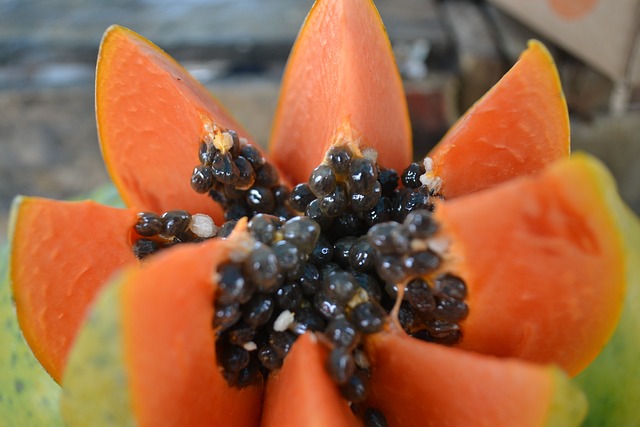The term superfood is sometimes used to describe food with high nutrient or phytochemical content that may confer health benefits, with few properties considered to be negative. Some of the most common superfoods are blueberries, broccoli and spinach. Although these foods are nutrient rich, their versatility pales when compared to papaya.
The papaya hails from the American tropics and can weigh as much as twenty pounds. In my opinion, papaya is the ultimate superfood because of its high enzyme content.
Enzymes are extremely important, as they are the catalyst in almost every biochemical process that takes place in the body. Their activity depends on the presence of adequate amounts of vitamins and minerals, especially magnesium.
Although there are three major categories of enzymes, I would like to focus on the one category that we should all consider when planning our meals, and, that is, the food enzymes. These enzymes are present in amble amounts of raw food and initiate the digestion process of food in the mouth and stomach. According to the late Dr. Edward Howell, a noted pioneer in the field of enzyme research, humans eating an enzyme poor diet, comprised primarily of cooked food, use up a tremendous amount of their enzyme potential in outpouring of secretions from the pancreas and other digestive organs. Dr. Howell believed that such outpouring results in a shortened life span.
Most fruits and vegetables contain few enzymes with the exception of papaya. Not only are papaya rich in carotenoids- vitamin A, vitamin C, potassium and phosphorous, they also contain a unique protein digesting enzyme (that is capable of digesting 200 times its own weight in protein). In addition, they contain healing properties. To say the papaya has 101 uses may be a bit of a stretch, but not so much.
Here is a list of just a few of the many ways one can benefit from the use of papaya:
- Use the sap or latex from the papaya tree to treat intestinal parasites, particularly tapeworms.
- The papaya’s emollient and antiseptic properties make it useful in treating infectious gastroenteritis, colitis, ulcers, IBS and infectious diarrhea.
- Papaya is useful in treating chronic pancreatitis because of its effect on all digestive processes and low fat content.
- Slightly green papaya has anti-bacteria properties and is useful in impeding the development of many pathogens such as e-coli, salmonella, staphylococcus and pseudomonas.
- Consume papaya regularly to address skin disorders such as eczema and acne because of its high anti-0xident and enzyme properties.
- Use papaya as a meat tenderizer.
- Use dried papaya seeds to make enzyme rich pepper. Grind in a pepper mill.
Those of you who have been reading my articles know that I highly recommend consuming raw and living foods. I also believe that your dinner plate should be comprised of 80 percent raw food and 20 percent cooked. If you follow the 80/20 rule you will automatically lessen the stress on your pancreas and other digestive organs, and enhance your digestion. The best way to eat papaya is fresh. Unfortunately papayas purchased in non-tropical countries are harvested before they are ripe and are less tasty. A great way to awaken this enzymatic superfood and enhance its flavor is by allowing it to ferment. The recipe below will help you add the awesome protein digesting enzyme of the papaya to each meal and increase your life-span.
PAPAYA CHUTNEY – (makes 1 quart)
3 cups ripe papaya, peeled and cubed
1 tablespoon of freshly grated ginger
1 red pepper, seeded and cut into a thin strips
1 small chopped onion
1 jalapeno pepper, seeded and chopped
½ cup fresh mint leaves, cut into pieces
1 bunch cilantro, chopped
1/8 cup of Rapadura (dehydrated cane sugar)
½ cup of lime juice
2 teaspoons of sea salt
½ cup of filtered water
Mix papaya with ginger, peppers, onions, mint and cilantro and place in a quart sized, wide mouth mason jar. Press down lightly with a wooden pounder or meat hammer. Mix the remaining ingredients and pour into jar, adding more water if necessary to cover the fruit. You can also use a culture starter such as Culture Starter for Vegetables by Body Ecology. The chutney should be at least 1 inch below the top of the jar. Cover tightly and leave at room temperature for 2-days before refrigerating.
This should be eaten within 2 months.
If the above recipe is just too hard-core make a smoothie instead. Because of its digestibility and nutritional richness, papaya is considered the perfect breakfast throughout the tropics. A papaya shake is one of the most pleasant ways of eating this fruit. Try this simple, but tasty smoothie.
TROPICAL SMOOTHIE
1 scoop of Green Food of your choice
1 banana
1-2 cups of papaya
1 cup Greek vanilla yogurt
1 handful of ice cubes
Place all items in blender and pulse using ice crusher. Blend until smooth and well combined. Enjoy!
Resources:
Nourishing Traditions, Sally Fallon with Mary G. Enig, PhD
Editorial Safe Liz SL Education and Health Library Encyclopedia of Medicinal Plants Madrid: Poligono Industrial La Mina Volume 2



